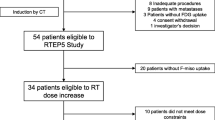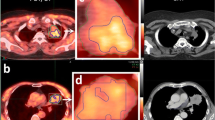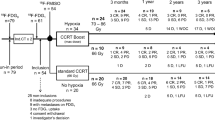Abstract
Objectives
This study was to evaluate the feasibility of simultaneous integrated boost on tumor hypoxia area by studying the dosimetric change of hypoxia imaging guidance on intensity-modulated radiation therapy for non-small cell lung cancer (NSCLC).
Methods
Five NSCLC patients with large hypoxic volume participated in this study. FDG PET/CT images were fused with CT localization images to delineate gross tumor volume. FMISO PET/CT images were fused with CT localization images to delineate hypoxic biological target volume (BTV) (tissue maximum ratio ≥ 1.3) by threshold. BTV was irradiated with 72, 78 and 84 Gy, respectively, 30 times. The dosimetry differences were compared in target volume and organ at risk between simultaneous integrated boost plans and conventional radiotherapy plans.
Results
Dosages on BTV of NSCLC hypoxic area were increased to 72, 78 and 84 Gy, respectively, by simultaneous integrated boost intensity-modulated radiation therapy. There was no obvious difference in dosage distributions on original target volume compared with those in conventional radiotherapy. Dosages on main organ at risk in chest met the dosimetric constraint, and there was no significant difference compared with those in conventional radiotherapy.
Conclusion
It is feasible in dosiology that the dosages in NSCLC hypoxic area were added to 72, 78 and 84 Gy by simultaneous integrated boost with the guidance of 18F-FMISO PET/CT.




Similar content being viewed by others
References
Torre LA, Bray F, Siegel RL, Ferlay J. Global cancer statistics, 2012. CA Cancer J Clin. 2015;65:87–108.
Travis WD, Brambilla E, Riely GJ. New pathologic classification of lung cancer: relevance for clinical practice and clinical trials. J Clin Oncol. 2013;31(8):992–1001.
Li L, Hu M, Zhu H, Yang G, Yu J. Comparison of 18F-fluoroerythronitroimidazole and 18F-fluorodeoxyglucose positron emission tomography and prognostic value in locally advanced non-small-cell lung cancer. Clin Lung Cancer. 2010;11(5):335–40.
Thomlinson RH, Gray LH. The histological structure of some human lung cancers and the possible implications for radiotherapy. Br J Cancer. 1955;9(4):539.
Eschmann SM, Paulsen F, Reimold M, Dittmann H, Welz S, Reischl G, et al. Prognostic impact of hypoxia imaging with 18F-misonidazole PET in non-small cell lung cancer and head and neck cancer before radiotherapy. J Nucl Med. 2005;46(2):253–60.
Zimny M, Gagel B, DiMartino E, Hamacher K, Coenen HH, Westhofen M, et al. FDG—a marker of tumour hypoxia? A comparison with [18F] fluoromisonidazole and pO2-polarography in metastatic head and neck cancer. Eur J Nucl Med Mol Imaging. 2006;33(12):1426–31.
Gagel B, Reinartz P, Dimartino E, Eble MJ. pO2 polarography versus positron emission tomography ([(18)F] fluoromisonidazole, [(18)F]-2-fluoro-2′-deoxyglucose). An appraisal of radiotherapeutically relevant hypoxia. Strahlenther Onkol. 2004;180(10):616–22.
Bowen SR, Kogel AJVD, Nordsmark M, Bentzen SM, Jeraj R. Characterization of positron emission tomography hypoxia tracer uptake and tissue oxygenation via electrochemical modeling. Nucl Med Biol. 2011;38(6):771–80.
Brustugun OT. Hypoxia as a cause of treatment failure in non-small cell carcinoma of the lung. Semin Radiat Oncol. 2015;25(2):87–92.
Popple RA, Ove R, Shen S. Tumor control probability for selective boosting of hypoxic subvolumes, including the effect of reoxygenation. Int J Radiat Oncol Biol Phys. 2002;54(3):921–7.
Corvo R, Santoni R, Magrini SM, Maurizi ER. Radiobiology as a basic and clinical medical science: what the physicists have forgotten. Tumori. 2016;102(1):e8.
Henk JM, Smith CW. Radiotherapy and hyperbaric oxygen in head and neck cancer. Interim report of second clinical trial. Lancet. 1977;2(8029):104–5.
Cade IS, McEwen JB, Dische S, Saunders MI, Watson ER, Halnan KE, et al. Hyperbaric oxygen and radiotherapy: a Medical Research Council trial in carcinoma of the bladder. Br J Radiol. 1978;51(611):876–8.
Overgaard J. Clinical evaluation of nitroimidazoles as modifiers of hypoxia in solid tumors. Oncol Res. 1994;6(10–11):509–18.
Grau C, Prakash Agarwal J, Jabeen K, Rab Khan A, Abeyakoon S, Hadjieva T, et al. Radiotherapy with or without mitomycin c in the treatment of locally advanced head and neck cancer: results of the IAEA multicentre randomised trial. Radiother Oncol. 2003;67(1):17–26.
Lardinois D, Weder W, Hany TF, Kamel EM, Korom S, Seifert B, et al. Staging of non-small-cell lung cancer with integrated positron-emission tomography and computed tomography. N Engl J Med. 2003;348(25):2500–7.
Chang JH, Wada M, Anderson NJ, Lim Joon D, Lee ST, Gong SJ, et al. Hypoxia-targeted radiotherapy dose painting for head and neck cancer using (18) F-FMISO PET: a biological modeling study. Acta Oncol. 2013;52:1723–9.
Bartlett RM, Beattie BJ, Naryanan M, Georgi JC, Chen Q, Carlin SD, et al. Image-guided pO2 probe measurements correlated with parametric images derived from 18F-fluoromisonidazole small-animal PET data in rats. J Nucl Med. 2012;53:1608–15.
Koch CJ, Giandomenico AR, Iyengar CW. Bioreductive metabolism of AF-2[2-(2-furyl)-3-(5-nitro-2-furyl)acrylamide] combined with 2-nitroimidazoles. Implications for use as hypoxic cell markers. Biochem Pharmacol. 1993;46:1029–36.
Mortensen LS, Johansen J, Kallehauge J, Primdahl H, Busk M, Lassen P, et al. FAZA PET/CT hypoxia imaging in patients with squamous cell carcinoma of the head and neck treated with radiotherapy: results from the DAHANCA 24 trial. Radiother Oncol. 2012;105:14–20.
Bentzen SM, Gregoire V. Molecular imaging-based dose painting: a novel paradigm for radiation therapy prescription. Semin Radiat Oncol. 2011;21(2):101–10.
Sovik A, Malinen E, Olsen DR. Strategies for biologic image-guided dose escalation: a review. Int J Radiat Oncol Biol Phys. 2009;73(3):650–8.
Christian JA, Bedford JL, Webb S, Brada M. Comparison of inverse-planned three-dimensional conformal radiotherapy and intensity-modulated radiotherapy for non-small-cell lung cancer. Int J Radiat Oncol Biol Phys. 2007;67(3):735–41.
Yom SS, Liao Z, Liu HH, Tucker SL, Hu CS, Wei X, et al. Initial evaluation of treatment-related pneumonitis in advanced-stage non-small-cell lung cancer patients treated with concurrent chemotherapy and intensity-modulated radiotherapy. Int J Radiat Oncol Biol Phys. 2007;68(1):94–102.
Palma DA, Senan S, Oberije C, Belderbos J, de Dios NR, Bradley JD, et al. Predicting esophagitis after chemoradiation therapy for non-small cell lung cancer: an individual patient data meta-analysis. Int J Radiat Oncol Biol Phys. 2013;87(4):690–6.
Funding
This study was supported by Henan Provincial Department of Science, China, 142102310052.
Author information
Authors and Affiliations
Corresponding author
Ethics declarations
Conflict of interest
The authors declare that they have no conflict of interest.
Ethical approval
All procedures performed in studies involving human participants were in accordance with the ethical standards of The First Affiliated Hospital of Zhengzhou University.
Informed consent
Informed consent was obtained from all individual participants included in the study.
Rights and permissions
About this article
Cite this article
Li, H., Xu, D., Han, X. et al. Dosimetry study of 18F-FMISO + PET/CT hypoxia imaging guidance on intensity-modulated radiation therapy for non-small cell lung cancer. Clin Transl Oncol 20, 1329–1336 (2018). https://doi.org/10.1007/s12094-018-1864-x
Received:
Accepted:
Published:
Issue Date:
DOI: https://doi.org/10.1007/s12094-018-1864-x




